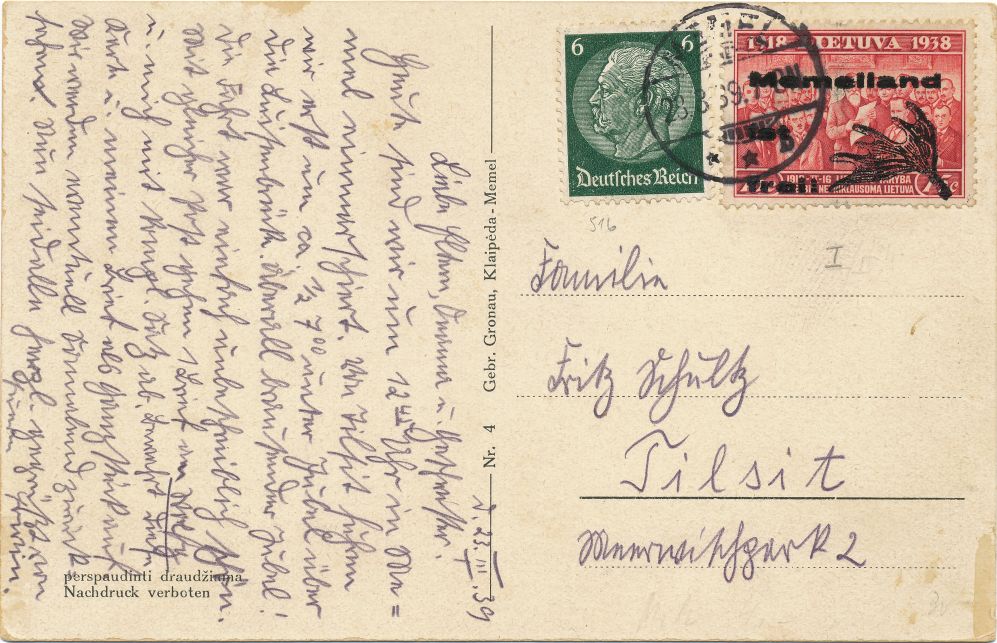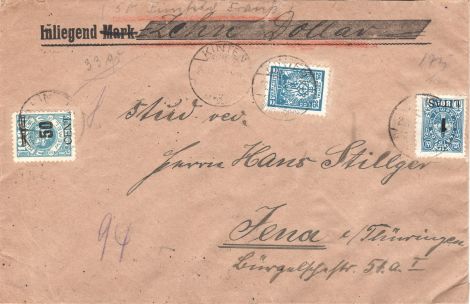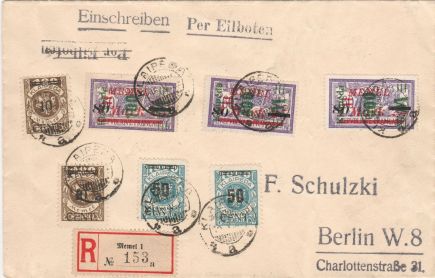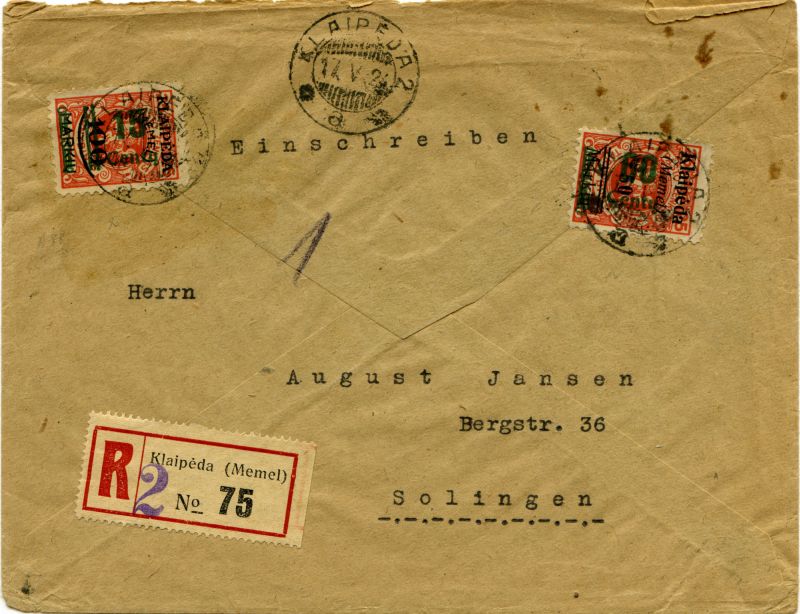Lithuania
-
Royal Polish Post
-
Imperial Russian Post
-
German Occupation / Ob. Ost
-
Independent Republic of Lithuania
-
Central Lithuania
-
Memel Area / Klaipėda
Contemporary History
The Memel region came into being in the course of the reorganisation of East Central Europe after the First World War. In accordance with Article 99 of the Treaty of Versailles, the German Reich ceded the Memel region to the Allied powers, the so-called Entente, on January 10, 1920. France, as the representative of the Entente, took over the mandate administration on February 15, 1920.
Lithuanian irregulars took advantage of the simultaneous occupation of the Ruhr to illegally occupy the Memel region on the third anniversary of the mandate's administration, January 10, 1923. The Paris Ambassadors' Conference of the Entente sanctioned the occupation subsequently on February 16, 1923, under the condition of an autonomous administration of the Memel region as a unit.
With the signing of the Klaipėda Convention including the Klaipėda statute and its ratification by the Lithuanian Parliament on May 8, 1924, the Memel region became part of the Lithuanian territory as an entity under international law, but retained a number of autonomy rights.

Emergency money of the city of Tilsit from November 1921 with a beautiful illustration of the situation in the Memel Land border area.
Following a German ultimatum, Lithuania ceded the Memel region to the German Reich on March 22, 1939. It remained part of the German state until 1944/45, when the first parts were evacuated in October 1944 and the entire Memel region fell into Soviet hands with the fall of the Memel fortress on January 27, 1945. From January 1945, the former Memel region formed part of the Lithuanian Soviet Socialist Republic, and since 1991 it has once again belonged to the Republic of Lithuania.
Postal history
German Reich stamps were used until the issue of their own stamps on July 7, 1920, after which they could be used up until July 20, 1920. In February 1920, the French mandate administration formed the Memel Regional Postal Directorate, which continued to apply the postal regulations of the German Reichspost, including postage.
Lithuania introduced its own currency in October 1922, the litas at 100 cents. The litas was pegged to the gold standard at a ratio of 10:1 to the US dollar.
Even after the military occupation of the Memel region by Lithuanian irregulars on January 10, 1923, and the subordination of the Memel Regional Postal Directorate to the Lithuanian Ministry of Transport, the rules of the German Reichspost continued to apply until April 15, 1923, before all postal services had to be paid in litas from the following day.
After the introduction of the Lithuanian currency, the litas, on April 16, 1923 in the Memel region, the stamps of the Memel region in mark currency were still usable until March 31, 1923 (Mi No. 1–120 of the French mandate administration) resp. until June 9, 1923 (Mi No. 121–166 of the Lithuanian administration). In order to determine the correct Lithuanian postal charges in litas for frankings in mark currency, the Deutsche Reichsbank calculated the daily rate mark : litas in a highly complicated procedure in which the US dollar also served as the reference currency.
This procedure led to a hopeless overload of all those involved, so that in the period April 16 – June 9, 1923, postage was often not calculated and used correctly. The entire currency changeover happened in a hurry and without sufficient information for those affected. The newspaper "Memeler Dampfboot" of April 18, 1923 vividly describes the situation:
„The new postal tariff, by the way, has caused hopeless confusion. … The damage this will cause to the economic life of the Memellanders, who are completely connected to traffic with the German Reich and have to meet their business obligations, will be incalculable unless an immediate remedy is found in the form of a clear postal tariff that everyone can understand. Since the Lit is not yet in circulation as a means of payment, the Memellander must pay in marks. The consequence is that the postage rates, expressed in marks, change every day. In fact, they will probably become higher every day, since the dollar, according to whose respective value the Lit changes, is currently showing an upward tendency. All in all, one cannot shake off the impression that once again an inadequately prepared measure is to be carried out by hook or by crook, causing serious damage of this kind. In response to many enquiries, we can inform you that the Lithuanian Memel stamps may continue to be used, but the amount of Mark corresponding to the cents must be affixed to these stamps. The cents are converted into marks at the exchange rate of the day, which must be checked beforehand.“
On 1 October 1923, new postage rates were introduced in the whole of Lithuania, including the Memel region.
The following periods can be distinguished in the Memel area between 1920 and 1925:
Date
Currency
Country
Stamp issues
and usesFebruary 15, 1920
until July 6, 1920Mark currency
French Mandate administration
Use of German Reich
stamps (forerunner) until July 20, 1920July 7, 1920
until April 15, 1923Mark currency
French Mandate Administration
Memel area Mi No. 1-120
stamps valid until March 31, 1923)Mark currency
Lithuania
(from January 10, 1923)Memel Territory Mi No. 121-166
(stamps valid until June 9, 1923)April 16, 1923
until May 8, 1924
(from October 1, 1923
new, uniform tariffs
for the whole of Lithuania)Litas currency,
Conversion of the
mark currency
at the daily rateLithuania
Memelgebiet Mi No. 167-237
(stamps valid until 31 August 1925)from May 8, 1924
Litas currency
Lithuania
Use of stamps
of the Republic of Lithuania
from Mi No. 138 (litas currency)For shipments to Estonia and Latvia, Lithuanian domestic rates applied from April 16, 1923; for those to the German Reich, foreign rates applied temporarily from April 16 to October 31, 1923, and then domestic rates again.
Only when the Memel Convention and the Memel Statute came into force on May 8, 1924, did the unrestricted use of Lithuanian stamps become possible. The Lithuanian administration had already unilaterally permitted the use of Lithuanian stamps from August 5, 1923, so that mixed frankings of three postal areas were possible. (Source: Michel DEU Spezial 2015, p. 957).
The stamps of the Memel region in litas currency (Michel Nos. 167–237) retained their postal validity until August 31, 1925. From June 1, 1925 until the return of the Memel region to the German Reich, only Lithuanian stamps were sold at the post office counters.
From 1925 to 1939, there were only Lithuanian stamps in the Memel region as part of Lithuania (see Independent Republic of Lithuania).
Local issue "Memelland ist frei"
From March 22, 1939, Lithuanian stamps Michel Nos. 425-428 with the overprint of an elk's shovel and the three-line text "Memelland ist frei" (Memelland is free) were sold by private Germans in the vestibule of the main post office in Memel (i.e. not over the post office counter by Reichspost officials!) (Mi Nos. I-IV). The German postal administration tolerated their sale and franking until March 31, 1939. Postage due was not charged on mail items.
Postal items exist either with this overprint stamp alone or in "mixed franking" with Lithuanian or German stamps valid at the time:

„Überall brausender Jubel“ (Roaring cheers everywhere)
Picture postcard from a contemporary witness with local issue and German stamp in "mixed franking" dated March 23, 1939, the day on which the German Reichspost effectively took over the postal system of the Memel region.
Each stamp alone covered the necessary postage. The postcard required a franking of 6 Reichspfennig as domestic mail. Lithuanian stamps remained valid under the German administration in 1939 until 31 March and were converted from litas to Reichsmarks at a ratio of 2.5:1. Here, 15 cents were equivalent to 6 pfennigs. From April 1, 1939, only German stamps were used.
Literature
The publications on the history of the Memel region and its stamps are numerous due to the great interest; here is a small selection of productive presentations:
Baumgartner, Fred W.: From Memel to Klaipeda. In: LPS 219 (1995) p. 13––17
Eberling, Serge: Memelgebiet. Les timbres du territoire de Memel sous l´administration française de 1920 à 1923. (The stamps of the Memel region under French administration 1920 – 1923). Paris 2007
Gerns, Kurt: Memel – Collecting area with claims. In: DBZ Deutsche Briefmarken-Zeitung. Jg. 1986 / 4, 6, 7, 9, 10 (Article in five parts).
Huylmans, Tobias: Memel Region – Handbook of Postmarks 1920–1925. Wiesbaden 2013.
Lindeiner, Christoph v.: Die Verwendung von Briefmarken in Mark-Währung im Memelgebiet ab 16. April 1923. In: Lituania 31 (2009) S. 2–17. (Der Autor hat eine Fülle von Artikeln in verschiedenen Zeitschriften wie Lituania und HBG Het Baltische Gebied veröffentlicht.)
Jusserand, Bernard: Les Français à Memel 1920 – 1923 Étude des tarifs postaux – The French in Memel 1920–1923. Study of postal rates. In: Lituania 35 (2011)
Ludwig, J. W. Heinz: The postage stamps of the Memel region 1920 – 1925. Manual - Catalogue. Neuss 2004. (the most up-to-date and detailed handbook since the publications of the great Memel specialist engineer Ernst Becker).
Marshall, Eugene R.: Lithuania seizes control of the Memel region. In: Lituania 20 (2003) S. 1320-1333 (Part I); Lituania 22 (2004) S. 1490-1492 (Part 2) (Report of a contemporary who reported as a journalist for an American newspaper; Very detailed source with a lot of data)
Žalis, Vytautas: Kova dėl identiteto. Kodėl Lietuvai nesiseke Klaipėdoje tarp 1923 – 1939 m. / Struggling for Identity. Why Lithuania did not succeed in the Memel region between 1923 and 1939. Lüneburg 1993. (Lithuanian/German; very critical detailed study of the relationship between "Greater" and "Lesser" Lithuania)
Webs
https://en.wikipedia.org/wiki/Klaipėda_Region
https://www.huylmans.de -
Soviet Occupation
-
German Occupation / Ostland
-
Camp Mail / Lithuanians in Exile
-
Independent Republic of Lithuania (restored)
-
Private Mail in Lithuania










